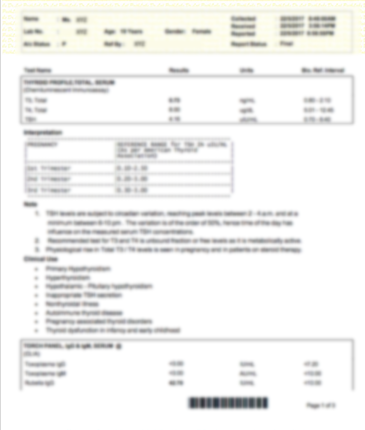CA15.3 - Breast Cancer marker
- C1050
Rs 1265
- Why Get Tested?
To monitor the response to treatment of invasive breast cancer and to help watch for recurrence of the disease - When To Get Tested?
When you have been or are being treated for invasive breast cancer - Sample Type:SERUM (SST or Plain)
- Fasting :NO
- Report Delivery:within 48 Hrs of Test Schdule
- Components:1 Observations
- Also Known As:
CA-Breast Cancer Antigen-Breast - Formal Name:
Cancer Antigen 15-3 - Sample Instructions:
A blood sample drawn from a vein in your arm - Test Preparation Needed?
None - What Is Being Tested?
Cancer antigen 15-3 (CA 15-3) is a protein that is produced by normal breast cells. In many people with cancerous breast tumors, there is an increased production of CA 15-3 and the related cancer antigen 27.29. CA 15-3 does not cause cancer; rather, it is shed by the tumor cells and enters the blood. This test measures CA 15-3 in the blood. Since CA 15-3 can be measured in the blood, it is useful as a tumor marker to follow the course of the cancer. CA 15-3 is elevated in fewer than 50% of women with early localized, breast cancer or with a small tumor, but is elevated in about 80% of those with breast cancer that has spread (metastatic). Because not all women with invasive breast cancer will have elevated CA 15-3, the test is not useful in all cases. CA 15-3 is not recommended as a screening test to detect breast cancer in women because it is non-specific. It may also be elevated in healthy people and in individuals with other cancers such as colon, lung, pancreas, ovarian, or prostate malignancies or certain conditions such as cirrhosis, hepatitis, and benign breast disease. How is the sample collected for testing? A blood sample is obtained by inserting a needle into a vein in the arm. Is any test preparation needed to ensure the quality of the sample? No test preparation is needed. - How Is It Used?
The cancer antigen 15-3 (CA 15-3) test and the related CA 27.29 test are mainly used to monitor response to breast cancer treatment and to help watch for breast cancer recurrence. They are used along with other clinical evaluations and tests, such as estrogen and progesterone receptors, Her2/neu, and gene expression tests for breast cancer, to evaluate a person's breast cancer. CA 15-3 is sometimes ordered to provide a general sense of how much cancer may be present (the tumor burden). CA 15-3 can only be used as a marker if the cancer is producing elevated amounts of it, so this test is not useful for all people with breast cancer. The CA 15-3 and CA 27.29 tests are not sensitive or specific enough to use as a screening test for cancer because non-cancerous conditions can cause elevated levels. - When Is It Ordered
CA 15-3 may be ordered along with other tests when advanced breast cancer is first diagnosed to help determine cancer characteristics and treatment options. If CA 15-3 is initially elevated, then it may be ordered periodically to monitor the effectiveness of treatment and to help watch for recurrence. CA 15-3 is usually not ordered when breast cancer is detected early, before it has spread (metastasized), because levels will not be elevated in the majority of early cancers. - What Does The Test Result Mean?
In general, the higher the CA 15-3 level, the more advanced the breast cancer and the greater the amount of cancer present (tumor burden). CA 15-3 concentrations tend to increase as the cancer grows. In metastatic breast cancer, the highest levels of CA 15-3 often are seen when the cancer has spread to the bones and/or the liver. Increasing concentrations of CA 15-3 over time may indicate that a person is not responding to treatment or that the cancer is recurring. Normal CA 15-3 levels do not ensure that a person does not have localized or metastatic breast cancer. It may be too early in the disease process for elevated levels of CA 15-3 to be detected or the person may be one of the roughly 20% to 25% of individuals with advanced breast cancer whose tumors do not shed CA 15-3. Mild to moderate elevations of CA 15-3 are seen in a variety of conditions, including cancer of the lung, pancreas, ovary, prostate, and colon as well as cirrhosis, hepatitis, and benign breast disorders and in a certain percentage of apparently healthy individuals. The CA 15-3 elevations seen in non-cancerous conditions tend to be stable over time. - Is There Anything Else I Should Known?
Laboratories may use different methods to test for CA 15-3, so results can vary from lab to lab. If you are having a series of CA 15-3 tests done, it is advised that you have the tests done by the same method, typically by the same laboratory, so that the results can be compared and interpreted correctly. You may wish to discuss this issue with your healthcare practitioner. Levels of CA 15-3 are not usually measured immediately after breast cancer treatment begins. There have been instances of transient increases and decreases in CA 15-3 that do not correlate with the person's progress. Usually, the healthcare practitioner will wait a few weeks after starting treatment to begin monitoring CA 15-3 levels.
Frequently Booked Test
Absolute Eosinophil Count
-
C1214
-
5-a-Dihydrotestosterone (5a DHT)
-
within 72 Hrs of Test Schdule
₹ 350.00
Absolute Eosinophil Count
-
C1214
-
5-a-Dihydrotestosterone (5a DHT)
-
within 72 Hrs of Test Schdule
₹ 350.00
Absolute Eosinophil Count
-
C1214
-
5-a-Dihydrotestosterone (5a DHT)
-
within 72 Hrs of Test Schdule
₹ 350.00
